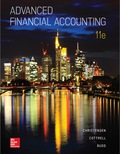
Concept explainers
a.
To prepare:
Introduction: An asset is a resource owned by business either tangible or intangible form to produce economic value. It provides the future benefits to the business. It is used to increase the value of firm by providing benefits.
a.
Explanation of Solution
In the books of Company F:
Record transfer of assets and liabilities:
| Date | Account | Debit ($) | Credit($) |
| Investment in Company K common stock | 66,000 | ||
| 28,000 | |||
| Accounts Payable | 22,000 | ||
| Cash | 15,000 | ||
| | 24,000 | ||
| Inventory | 9,000 | ||
| Land | 3,000 | ||
| Depreciable Assets | 65,000 | ||
| (To record formation of subsidiary.) |
Table (1)
- Investment in Company K common stock is an asset and it is increased by $66,000. Therefore, Investment in Company K common stock account is debited with $66,000.
- Accumulated depreciation is a contra asset and it is decreased by $40,000. Therefore, Accumulated depreciation account is debited with $40,000.
- Accounts Payable is a liability and it is decreased by $22,000. Therefore, Accounts Payable account is debited with $22,000.
- Cash is an asset and it is decreased by $15,000. Therefore, cash account is credited with $15,000.
- Accounts Receivable is an asset and it is decreased by $24,000. Therefore, Accounts Receivable account is credited with $24,000.
- Inventory is an asset and it is decreased by $9,000. Therefore, Inventory account is credited with $9,000.
- Land is an asset and it is decreased by $3,000. Therefore, Land account is credited with $3,000.
- Depreciable Asset is an asset and it is decreased by $65,000. Therefore, Depreciable Asset account is credited with $60,000.
b.
To prepare: Journal entries that subsidiary company would record.
Introduction: An asset is a resource owned by business either tangible or intangible form to produce economic value. It provides the future benefits to the business. It is used to increase the value of firm by providing benefits.
b.
Explanation of Solution
In the books of subsidiary company:
Record transfer of assets and liabilities:
| Date | Account | Debit ($) | Credit($) |
| Cash | 15,000 | ||
| Accounts Receivable | 24,000 | ||
| Inventory | 9,000 | ||
| Land | 3,000 | ||
| 65,000 | |||
| Accumulated depreciation | 28,000 | ||
| Accounts Payable | 22,000 | ||
| Common Stock | 48,000 | ||
| Additional paid in capital | 18,000 | ||
| (To record receipt of assets and liabilities and issuance of stock.) |
Table (2)
- Cash is an asset and it is increased by $15,000. Therefore, cash account is debited with $15,000.
- Accounts Receivable is an asset and it is increased by $24,000. Therefore, Accounts Receivable account is debited with $24,000.
- Inventory is an asset and it is increased by $9,000. Therefore, Inventory account is debited with $9,000.
- Land is an asset and it is increased by $3,000. Therefore, Land account is debited with $3,000.
- Depreciable Assets is an asset and it is increased by $65,000. Therefore, Depreciable Assets account is debited with $65,000.
- Accumulated depreciation is a contra asset and it is increased by $28,000. Therefore, Accumulated depreciation account is credited with $28,000.
- Accounts Payable is a contra asset and it is increased by $22,000. Therefore, Accounts Payable account is credited with $22,000.
- Common Stock is equity and it is increased by $48,000. Therefore, Common Stock account is credited with $48,000.
- Additional paid in capital is equity and it is increased by $18,000. Therefore, Additional paid in capital account is credited with $18,000.
Want to see more full solutions like this?
Chapter 1 Solutions
EBK ADVANCED FINANCIAL ACCOUNTING
- Dion Traders has a selling price of $75, variable costs of $60, and fixed costs are $90,000. How many units must be sold to break even? A) 4,500 B) 6,000 C) 3,000 D) 7,500arrow_forwardGeneral accounting questionarrow_forwardIn December 2019, Solar Systems Inc. management establishes the 2020 predetermined overhead rate based on direct labor cost. The information used in setting this rate includes estimates that the company will incur $920,000 of overhead costs and $600,000 of direct labor cost in year 2020. During March 2020, Solar Systems began and completed Job No. 20-78. What is the predetermined overhead rate for year 2020?arrow_forward
- What is the earings per share?arrow_forwardRiverdale Manufacturing purchased a production machine on January 15, 2025, for $82,500. The estimated useful life of the machine is 8 years, and the residual (salvage) value is $7,500. Compute the annual depreciation expense for Year 1 and Year 2 using the straight-line method.arrow_forwardI am searching for the accurate solution to this general accounting problem with the right approach.arrow_forward
 Financial AccountingAccountingISBN:9781337272124Author:Carl Warren, James M. Reeve, Jonathan DuchacPublisher:Cengage Learning
Financial AccountingAccountingISBN:9781337272124Author:Carl Warren, James M. Reeve, Jonathan DuchacPublisher:Cengage Learning

